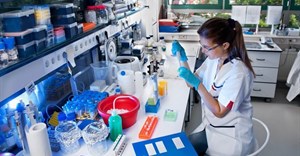Subscribe & Follow
#CannesLions
- Final Grande Prix and LionsDanette Breitenbach
- Day 3: Grande Prix and Gold winners announcedDanette Breitenbach
Trending
 MultiChoice mourns the death of Nkateko MabasoKarabo Ledwaba
MultiChoice mourns the death of Nkateko MabasoKarabo Ledwaba




Jobs
- SAP Fiori Developer Johannesburg
- Junior - Mid-level C# Developers George
- Junior Digital Marketer Potchefstroom
- Part-time Lecturer Cape Town
- Ops Admin and Key Accounts Muizenberg
- Operations/Production Manager Pinetown
- Sales Support and Administration Cape Town
- Power BI Developer Johannesburg
- Social Media Community Manager Germiston
- Graphic Designer Cape Town
First microscopy centre for South Africa
The Centre for High Resolution Transmission Electron Microscopy (HRTEM) is based at the Nelson Mandela Metropolitan University in Port Elizabeth, Eastern Cape.
Nanoscience is the study of atoms, molecules and objects at microscopic scale. Nanotechnology, often referred to as "the science of small things" has numerous applications in the development and manufacture of new products.
"Without a doubt, this new centre for nanoscience and nanotechnology is going to mean big business for South Africa," says Prof Jan Neethling, head of the centre and one of the country's foremost electron microscopists.
The hi-tech HRTEM centre was established in collaboration with the National Research Foundation, the Department of Science and Technology, Sasol and the Department of Higher Education and Training.
"To be internationally competitive in materials research and nanoscience, South Africa needed a modern, high-resolution transmission electron microscopy facility," he says.
Bringing world-class technology to SA
Neethling says that until now South African scientists had to travel overseas to conduct research of this nature.
"For many years, South Africa couldn't afford or didn't realise the importance of putting money into a centre like this," he adds.
Now that the new centre is up and running, scientists can conduct world-class research without leaving the country.
Importance of electron microscopy research
Electron microscopy uses electron microscopes to view objects. This type of microscope is capable of much higher magnifications and has a greater resolving power than a light microscope, enabling the viewing of far smaller objects in finer detail.
Developments in electron microscopy over the past 80 years have yielded many important technological advances worldwide.
It has contributed to the development of modern engineering materials and the micro-electronics revolution, which has given the world access to television, mobile phones, optical fibre communication and computers.
In the medical field it has enabled biologists to study the structure of cells, bacteria and viruses.
Powerful microscopes on site
The centre is equipped with technology valued at R90-million ($11 million). The suite of instruments includes the Japanese-made high-resolution transmission electron microscope, which can analyse materials at atomic level. It's one of the world's highest resolution commercial analytical transmission electron microscopes.
There are also three additional hi-tech electron microscopes, each with different capabilities.
Having such advanced technology in South Africa is of major benefit to the country.
Neethling says it will help South Africa to become a manufacturing-driven nation and improve its international competitiveness.
"With our research and instruments we will be able to assist with the development of new products," he explains.
Many industries to benefit
Sectors that can benefit from research conducted at the centre include the aerospace and automotive industries, Sasol's coal-to-liquids technology, the cutting and drilling tool industry, nuclear energy, minerals beneficiation and sensor technologies such as infra-red.
The new technology will also make it possible to perform important research into national priorities, which include clean water, energy, mineral beneficiation and manufacturing.
Sasol will use the high-resolution microscope, in which it has invested R6-million ($764 000), to improve and analyse the catalysts required to make liquid fuels and chemicals from coal.
Element Six, which manufactures synthetic diamonds, will use the facility to improve the strength of oil drill bits composed of synthetic diamond particles held together by a strong glue-like compound.
Neethling says the development of these diamond tools relies heavily on nanoscale research using high-resolution electron microscopy.
Building design
The new facility is the most sophisticated building of its kind on the continent and had to be constructed in keeping with stringent requirements.
The HRTEM centre consists of two buildings: one houses the microscopes and the other accommodates staff and students.
The building and research centre had to be designed around the high resolution transmission electron microscope. The structure was built in such a way to protect the microscope from mechanical and acoustic vibrations and magnetic fields, as the slightest deviation could result in failure to see atoms.
The labs housing each microscope also have to be absolutely quiet to limit mechanical vibrations. To achieve this, a "room within a room" design was used.
Each lab is built on top of a large isolated concrete block, weighing 100 tons, positioned on a specially prepared graded substrate. Each concrete block and adjoining laboratory is separated from external walls by a 100mm air cavity on all four sides.
Source: MediaClubSouthAfrica.com
MediaClubSouthAfrica.com is hosted by the International Marketing Council of South Africa (IMC), the custodian of Brand South Africa. The site is a free service for all media professionals - journalists, editors, writers, designers, picture editors and more - as well as for non-profit organisations and private individuals. Its specific focus is on South Africa and Africa.
Go to: http://www.mediaclubsouthafrica.com/










